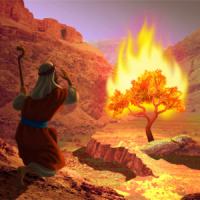
Moses had been brought up at the Egyptian court. He was obviously singled out for a special destiny, having been rescued from the river by Pharaoh’s daughter. Exodus does not recount anything of his relationship with the God of his ancestors, before he beheld the burning bush. All we know is that he was looking after his father-in-law’s sheep and caught sight of a bush that burned without being consumed. The first reading and the gospel both use plants as symbols. Fire represents God’s love, which burns eternally; the parable of the fig tree shows his patience with his people, giving added grace in the further nourishment of the barren tree.
God came down the mountain to meet Moses, as he went about his business of shepherding. Moses was told to remove his shoes out of respect for God’s presence. Previously, Moses had always been an alien in the society in which he lived. At the court of pharaoh, although adopted by the princess, he was still a Hebrew. He was rejected by his own people when he tried to intervene in a fight (Ex. 2:14) The Midianites, his wife’s people, called him an Egyptian (Ex. 2:19). Now, however, he was embraced by the God of his ancestors, so at last he had found a home. He would join the line of the patriarchs, Abraham, Isaac and Jacob, and he would lead his people back to the Promised Land. Like Amos, who was also a shepherd and a tender of sycamores (Amos 7:14-17), Moses was a reluctant prophet. He was probably leading a satisfactory life and did not want to be disturbed. God led him out of his comfort zone and helped him to develop the qualities which would make him one of Israel’s greatest leaders.